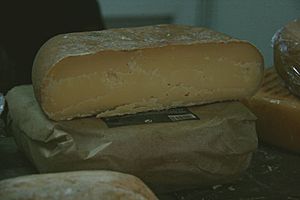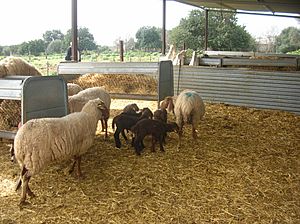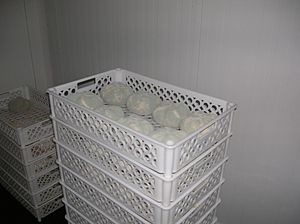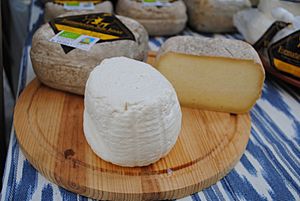Mallorca cheese facts for kids
Quick facts for kids Mallorca |
|
|---|---|

Mallorca cheese (cows' milk)
|
|
| Other names | Mallorquín |
| Country of origin | Spain |
| Region | Mallorca |
| Source of milk | Cow, goat, sheep |
| Texture | Semi-hard |
Mallorca cheese (called formatge mallorquí in the local Balearic dialect) is a special Spanish cheese. It is made only on the island of Mallorca, which is one of the Balearic Islands in the Mediterranean Sea.
This cheese has a special status called Protected Designation of Origin. This means it can only be made in Mallorca. It uses milk from cows, goats, or sheep that live on the island. The milk is also pasteurized, which means it's heated to kill germs.
Mallorca cheeses are shaped like flat cylinders. They are about 12–20 cm (5-8 inches) wide and 7-9 cm (3-4 inches) tall. They can weigh from 750 g to 4 kg (1.5-9 lbs).
There are three main types of Mallorca cheese, depending on how long they are aged:
- Semi-cured: Aged for at least 20 days.
- Cured: Aged for at least 45 days.
- Aged: Aged for at least 100 days.
Contents
How Mallorca Cheese Is Made
Making Mallorca cheese starts with milk that is 30-35°C (86-95°F) warm. A special ingredient called rennet is added to make the milk thicken, or coagulate. This takes at least 30 minutes.
The thick milk, called curd, is then cut into small pieces. This helps drain out the watery part, called whey. The curd is then put into special molds. These molds are lined with linen or cotton. The cheese is then pressed for at least 3 hours. This pressing uses a lot of force, between 2 and 6 kg/cm2.
After pressing, the cheeses are put in a salty water bath, called brine, for at least 18 hours. This adds flavor and helps preserve the cheese.
Aging and Maturation
Once salted, the cheeses are moved to a special room. This room is kept at 10-17°C (50-63°F) with high humidity. The cheese needs to age for at least 20 days.
After 7 days in the aging room, the cheeses are turned over. Their rinds are rubbed with olive oil. This is done many times as the cheese ages. The olive oil helps the cheese mature and gives the rind its special color and smell.
Mallorca cheese is not made in the summer. This is because the production is seasonal, meaning it depends on the time of year.
Most Mallorca cheese loaves are fairly small. They are usually about 6 x 15 cm and weigh between 500 and 1500 grams. They have a square shape with rounded corners.
What Mallorca Cheese Tastes Like
The smell of Mallorca cheese is mostly like dairy. Younger cheeses might smell a bit like butter or yogurt. As the cheese gets older, its smell becomes stronger.
The taste is a little salty and slightly tangy. The flavor becomes more intense as the cheese ages. Very old cheeses might even have a slight peppery taste and a bit of a dry feeling in your mouth.
Texture and Appearance
Mallorca cheese is easy to cut. The cut surface looks smooth and a bit shiny. The cheese feels firm and dense, but it's also a little bit elastic. Its color can be white or ivory-white.
Sometimes, especially in older cheeses, you might see a few small holes inside.
The Rind
The rind (the outside skin) of Mallorca cheese can be yellow or brownish. The color depends on how old the cheese is. The rind is usually soft and not too thick.
How People Enjoy Mallorca Cheese
Mallorca cheese is often eaten as a snack. People slice it and enjoy it by itself, or with wine or beer. It can also be part of a meal, served with fruits or nuts.
In the past, during medieval times, Mallorca cheese was used in many recipes. For example, it was part of sauces like "allimantega" (with garlic, butter, and eggs) and "almadroc" (with garlic). It was also grated over noodles and macaroni. People even used it in pastries called rubiols and in stuffings for goat meat. King Peter III of Aragon enjoyed fried cheeses and Mallorca cheese with pears!
See also
 In Spanish: Queso de Mallorca para niños
In Spanish: Queso de Mallorca para niños




